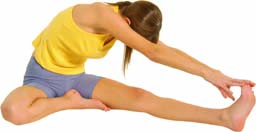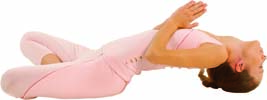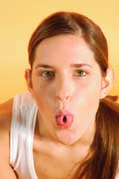Yoga for weight loss
Practicing yoga consistently and systematically improves relaxation and the union between the mind, body and spirit, to reduce the anxiety that makes us overeat. Among these benefits, physical yoga also contributes to a weight loss plan.
+ The postures or asanas for helping weight loss can be divided into three categories: those that massage the fatty tissue; those that affect the thyroid glands and those that help relaxation, diminishing the stress which can contribute to weight gain.
AGAINST FATTY TISSUE
The Crane and Half seated bend are poses that favor muscle tone and fight against fatty tissue.
The Crane

This posture is similar to the Seated forward bend, but done standing. Bringing similar benefits. This exercise massages the abdominal muscles and fatty tissue. It helps to prevent fat from accumulating. It also stretches the spinal column and back muscles.
Standing on your feet, looking straight ahead with your arms to the sides of your body, take a deep breath. When you exhale, lower your torso straight down. Bring your arms to the floor, and if you can, place the palms of your hands on the ground. Try to bring your forehead to your knees. Keep breathing comfortably and with the abdomen tight, bring your torso down lower. Next, lift your torso up bit by bit. With your arms loose and relaxed, feel how your torso lifts up, vertebrae per vertebrae. To avoid becoming dizzy when releasing, inhale and lift your arms over your head. Then exhale and bring them down.
Half seated bend
This is one of the most complete yoga poses, it has similar benefits to the Seated forward bend because it belongs to the same family of yoga poses. This position helps to fight weight gain, because it stretches and massages fatty tissue and helps your body to charge with energy and your mind to relax. This posture increases the flexibility of your back, leg muscles and knee joints and helps to fight against excess weight.

In a seated position, stretch out your left leg and bend your right leg, placing it on your inner left thigh so that your heel is touching your inner thigh. Keep your back straight and arms stretched. Take a deep breath and lift up your arms. While you exhale, lower your arms and torso over your left leg. Try to bring your forehead to your knee. Your hands should reach your ankle and if you can, the sole of your foot. Avoid unnecessary tension to lower all the way down. Continue breathing slowly. Stay in this position for as long as you feel comfortable. To release inhale and raise your arms. Then raise your torso. Exhale and lower your arms to your sides. Repeat with your other leg.
GENTLE EXERCISE
Yoga is a discipline designed to improve your flexibility and harmony. The exercises use gentle movements without straining your body. When practicing the asanas remember not to strain yourself. There is no need to push yourself too far. Remember to use gentle movements and don't push your body into a pose. Trough time and willpower, you will improve your body's health naturally and get in tune with your body.
FOR THE THYROID GLANDS
There are two poses that benefit the thyroid glands: the Fish and the Cobra.
The Fish
This posture is highly beneficial for your body: it regulates thyroid and pineal gland functions. It also stretches your abdominal muscles, helping to treat overweight.

Sit on your heels, with your back straight, looking forward and your hands on your thighs. Breathing freely, bring your head all the way back, arching your back. Rest your weight on your elbows and palms of your hands. Drop your head back so that the top of your head is on the floor. You should feel how your vertebrae press together and the area around your throat opens. When you are firmly placed in this position, bring your hands to your chest and place the palms of your hands together. Stay in this position for as long as you find comfortable. To come out of the pose, place your elbows on the floor, inhale, bring your chin to your chest and roll on to your right side while you exhale.
The Cobra
This asana is beneficial for the body because it regulates the suprarenal glands’ function, strengthens the back, increases the flexibility of the spine and helps to tone the abdominal muscles. In addition, it helps to increase your energy and to lift up your self-esteem. It helps to purify your body, important aspect when losing weight.

Lie down with your legs together and your forehead rested on the floor. Your legs should be straight with the front of your feet resting on the floor. Place your elbows, forearms and the palms of your hands on the floor. The palms of your hands should stay at the same height as your shoulders and your head should be slightly pressed against the floor. Contract your buttocks and lift up your chest, slowly so as not to harm the lower back. Extend your arms at the same time as you lift up your chest. If this causes any discomfort, don't strain yourself and keep your head looking forward. To release, slowly lower your body while you place on the ground: the abdomen, and lastly the chest, always stretched forward. Next, bring your chin to your chest and rest one cheek on the ground.
TO RELAX
To relax we recommend the Sitali breathing and Deep or diaphragmatic breathing.
Sitali breathing exercise
This exercise helps to calm hunger and thirst. It helps to purify your blood and improve sleep.

Stick out your tongue, so that the tip is over your lips. Fold your tongue to form a “tube” and breathe through your tongue. You will note that the air cools off your tongue. Continue inhaling in this pose for as long as you feel comfortable. Next, exhale through your nose.
DEEP OR DIAPHRAGMATIC BREATHING
Newborns use this breathing, which is the perfect breath. This breathing technique is a source of life that helps to calm your mind and control the anxiety that causes overeating. It lifts up your spirit, relieving the depression usually accompanied with overweight. It balances the nervous system, energizes and relaxes the muscles. It also helps to bring oxygen and purify the blood. It is called diaphragm breathing, because it uses this muscle.
• It's best to practice this technique lying down on the floor or on a padded mat. However, advanced practitioners can do this exercise sitting or standing up with their back straight.
• Take in deep breaths without your chest lifting up but from the abdomen. You should inhale slowly to fill the lungs; you should exhale completely before inhaling again.
• As the air passes through the throat you can press on the esophagus to produce a sound similar to snoring.
• Repeat 4 or 5 complete cycles.

Comment about this article, ask questions, or add new information about this topic: